
The Dorking Caves are a network of manmade tunnels excavated in the soft sandstone of the Upper Greensand deposits beneath Dorking in Surrey, England.

The Dorking Caves are a network of manmade tunnels excavated in the soft sandstone of the Upper Greensand deposits beneath Dorking in Surrey, England.
The present entrance to the caves is in South Street in the centre of Dorking.
There is evidence of a number of original entrances to the caves, including two shafts, but all with the exception of the South Street entrance have been sealed. The upper level of the caves is laid out as a wine cellar and was last used for this purpose in the 19th century. In the centre of the upper level is a set of steps leading down to a landing, from which leads a further set of steps to a lower passage. At the far end of this passage is a circular room with a bench cut out of the rock. [1]
The Dorking 'caves' are tunnels, being manmade and as such not caves in the true sense of the word (a natural underground/cliff-side space large enough for a human to enter). Dorking Caves is a long-used name and the one used in all promotional and official literature. [2] [3]
The exact age of the caves is unknown. Historian John Aubrey mentioned them in the late 17th century, praising their qualities as wine cellars, in which capacity parts of them served until the 19th century. Extensive graffiti adorns the caves, largely from the 18th and 19th centuries. The oldest date found inscribed on the walls is 1672. [3]
The caves formed a network connecting the cellars of buildings around the town and were probably used initially for storage, but have had a variety of uses including as hiding places for smugglers' contraband. One cave in High Street provided a venue for cock fighting while others according to recent oral tradition were used as a hiding places by persecuted religious groups (see European Wars of Religion) and secret societies. [3]
The caves are open to the public during the summer with tours organised by Dorking Museum. Prince Edward, Earl of Wessex, formally re-opened the caves to the public on his visit to the town on 11 March 2015. [4] [5]

Dorking is a market town in Surrey in South East England, about 21 mi (34 km) south of London. It is in Mole Valley District and the council headquarters are to the east of the centre. The High Street runs roughly east–west, parallel to the Pipp Brook and along the northern face of an outcrop of Lower Greensand. The town is surrounded on three sides by the Surrey Hills Area of Outstanding Natural Beauty and is close to Box Hill and Leith Hill.
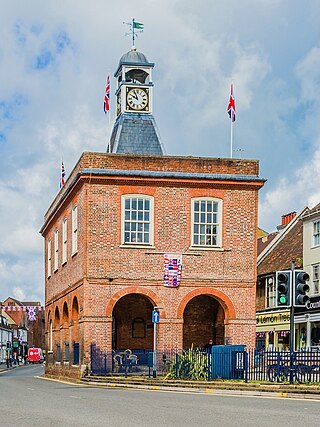
Reigate is a town in Surrey, England, around 19 miles (30 km) south of central London. The settlement is recorded in Domesday Book in 1086 as Cherchefelle and first appears with its modern name in the 1190s. The earliest archaeological evidence for human activity is from the Paleolithic and Neolithic, and during the Roman period, tile-making took place to the north east of the modern centre.

Denbies Wine Estate, near Dorking, Surrey, has the largest vineyard in England, with 265 acres (1.07 km2) under vines, representing more than 10 per cent of the plantings in the whole of the United Kingdom. It has a visitors' centre that attracts around 300,000 visits a year.
Timpanogos Cave National Monument is a United States National Monument protecting the Timpanogos Cave Historic District and a cave system on Mount Timpanogos in American Fork Canyon in the Wasatch Range, near Highland, Utah, in the United States. The site is managed by the National Park Service. The 1.5-mile (2.4 km) long trail to the cave entrance gains 1,092 feet (333 m) height, but it is paved and fairly wide making it accessible for most people. The three caves of the system, one of which is specifically called Timpanogos Cave, are only viewable on guided tours when the monument is open, usually from May through September depending on snow conditions and funding. There is the standard tour going through the cave system, and an Introduction to Caving tour which teaches Leave No Trace caving and goes further into Hansen Cave.

Deepdene was an estate and country house occupying land to the southeast of Dorking, Surrey, England. The remains of the gardens are Grade II* listed with the adjoining Chart Park on the Register of Historic Parks and Gardens.

Secret passages, also commonly referred to as hidden passages or secret tunnels, are hidden routes used for stealthy travel, escape, or movement of people and goods. They are sometimes inside buildings leading to secret rooms.
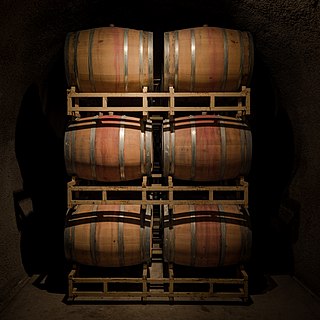
Wine caves are subterranean structures for the storage and the aging of wine. They are an integral component of the wine industry worldwide. The design and construction of wine caves represents a unique application of underground construction techniques.
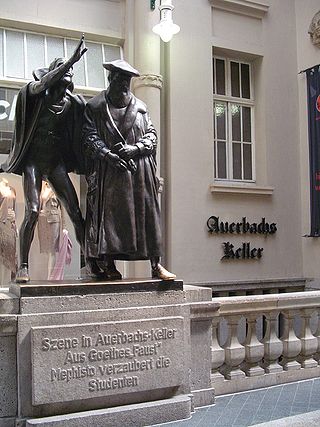
Auerbachs Keller is the second oldest restaurant in Leipzig, Germany. Already one of the city's most important wine bars by the 16th century, it owes its worldwide reputation to Goethe's play Faust as the first place Mephistopheles takes Faust on their travels.

The Odesa catacombs are a labyrinth-like network of tunnels located under the city of Odesa and its outskirts in Ukraine, that are mostly the result of stone mining, particularly coquina. The system of Odesa Catacombs consists of a network of basements, bunkers, drainage tunnels and storm drains as well as natural caves.

Dorking Deepdene railway station is a railway station in the town of Dorking, Surrey, England. Located on the North Downs Line, it lies 29 miles 65 chains from London Victoria. The station is one of three within Dorking, alongside Dorking West and Dorking. The station is within walking distance of Dorking station and interchange on a through ticket is permitted.
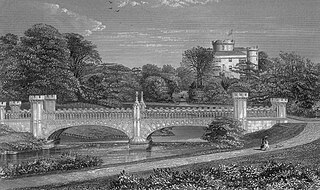
Mysterious tunnels or "secret passages" are a common element of the local folklore tradition in Europe. Such tunnels are said to physically link prominent places such as country houses, castles, churches, ancient monuments and other, often medieval, buildings.

Reigate Castle is a former castle in the town of Reigate in the county of Surrey, England. None of the castle buildings survive today, but a cave below the site, considered to be part of the castle, still exists. Known as "Baron's Cave", it is occasionally open to the public for tours.

The Lummelunda Cave is located in a nature reserve at Lummelunda north of Visby on Gotland, Sweden. The explored part of this karst cave is almost 4.5 km (2.8 mi), making it one of the longest caves in Sweden. It is created by the drainage water from the Martebo mire. The water forms a stream with its outlet in the Baltic Sea. In the 15th to 19th centuries, mills and an ironwork were set up by the stream.

The Znojmo Catacombs are a vast labyrinth of underground passageways, cellars and subcellars situated under the historic city of Znojmo, in the Czech Republic. They were initially developed for defensive purposes.
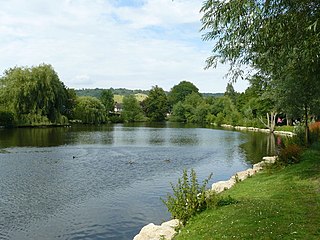
The Pipp Brook is a left-bank tributary of the River Mole, Surrey, England. It rises at two main springs north of Leith Hill on the Greensand Ridge, then descends steeply in a northward direction, before flowing eastwards along the Vale of Holmesdale. It runs to the north of Dorking High Street, before discharging into the Mole at Pixham.

The Golden Lion is a pub in Fulham, in the London Borough of Hammersmith and Fulham, London, England. It is located on Fulham High Street, to the east of Fulham Palace Gardens. Built in 1455 it is reported as the oldest pub in Fulham and was rebuilt by one of its Victorian owners. Notable patrons include the playwrights Shakespeare and Fletcher as well as Bishop Bonner.

Redcliffe Caves are a series of man made tunnels beneath the Redcliffe area of Bristol, England.
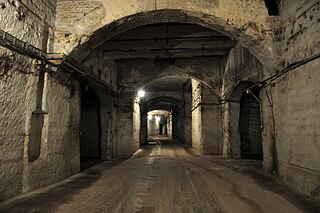
The Kőbánya cellar system or cellar system of Kőbánya, sometimes known to non-Hungarians simply as the Kőbánya Mine, or the Kobanya Mine, is an extensive network of subterranea, or underground spaces, in the 10th district of Budapest (Kőbánya), in Hungary. It is considered to be the largest cellar complex in the country. The complex as a whole started as an underground limestone quarry in a wine-growing area of present-day Kőbánya in the Middle Ages. Later wineries and beer breweries were established on the premises and they continued to use some of the underground spaces. During the Second World War, the dimensions of the complex enabled it to be used as a covert aircraft engine assembly plant and a civilian hideout. Since 2008, Kőbánya Asset Manager Jsc. organizes free guided tours annually, which introduce visitors to both the complex and the Havas Villa, one of the most notable properties connected to it. The underground complex is one of the locations that are participating in the European Heritage Days.

The Undercroft at 72/74 High Street in Guildford in Surrey is a medieval undercroft or storage room. It has been described as one of the finest examples of its type in the country. Since 1976 it has been a Grade II* listed building and Scheduled Monument on the List of Historic England.
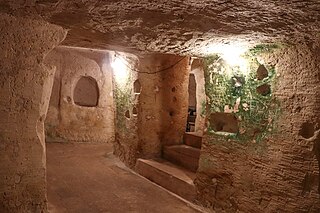
Matiate is an archaeological site underneath the town of Midyat, in Mardin province, Turkey. It is assumed to have been in use for 1,900 years, at its peak to have been inhabited by up to 70,000 people and is considered to be the largest cave system in the world.